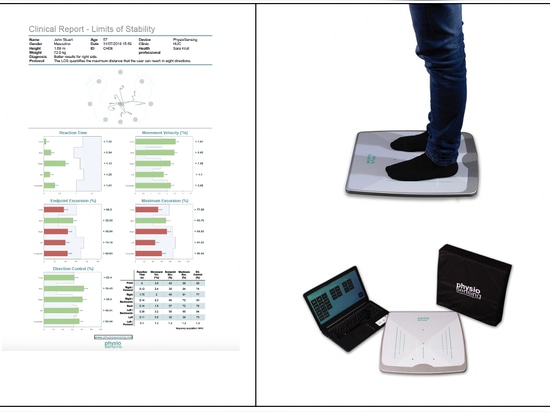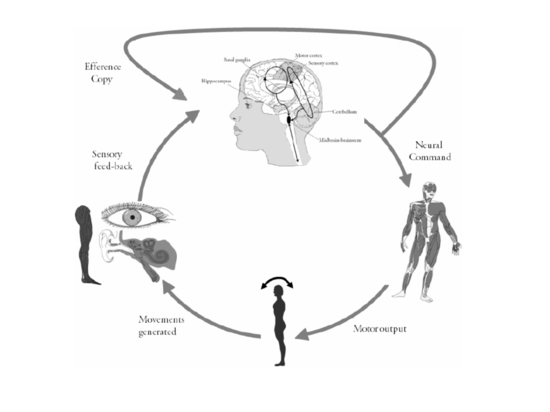
#Industry News
Virtual Reality Therapy for Vestibular Rehabilitation
-
1. Balance Mechanisms & Vestibular Disorders
Balance is the ability to maintain the body’s center of mass over its base of support. Balance is achieved and maintained by a complex set of sensorimotor control systems (Figure 1 – left) that include sensory input from vision (sight), proprioception (touch), and the vestibular system (motion, equilibrium, spatial orientation); integration of that sensory input; and motor output to the eye and body muscles [1]. When any of these systems is injured or deficient, balance can markedly be affected.
In particular, the vestibular system has a fundamental role in the sensation and perception of body position and movement, as well as eye movements during head motion. It is composed of three semicircular canals and two fluid-filled sacs (within the vestibule), located in the inner ear (Figure 1 – right). The fluid shifts with head movements, which stimulates the vestibular hair cell receptors that send the position changes to the brain, acting as a gravity sensor [2].
When the vestibular apparatus is damaged by any pathology, several clinical manifestations arise, such as dizziness or vertigo, increasing risk of falling and/or getting injured. Patients with vestibular dysfunction also show discomfort, decreased motor capacity and psychological distress, which leads to a functional decrease in daily tasks, especially those that require balance, rapid head rotation and good dynamic visual acuity. Other symptoms might include nausea and vomiting; diarrhea; changes in heart rate and blood pressure; blurred vision; and confusion or disorientation. Symptoms may come and go in short periods of time or last a long time, which lead to fatigue and depression. Several conditions can contribute to vestibular dysfunction, some of the most commonly diagnosed include:
Benign paroxysmal positional vertigo (BPPV),
Vestibular migraine,
Labyrinthitis (inflammation of the inner ear),
Ménière’s disease,
Vestibular neuritis (viral infection of the vestibular nerve),
Traumatic brain injury or concussion,
Stroke.
2. Vestibular Rehabilitation Therapy
One of the treatments for vestibular disorders is the vestibular rehabilitation. Vestibular rehabilitation aims at balance recovery, through exercise, using neuroplasticity mechanisms of the central nervous system – compensation, habituation and adaptation – so as to mitigate or eliminate the patient’s symptoms. The main elements of a vestibular rehabilitation treatment are: 1) habituation exercises – based on the repetition of exercises that trigger vertigo, until adaptation is achieved through repetition and habituation; 2) increase of vestibulo-ocular reflex gain and gaze stabilization – through visual stimulus (such as optokinetic stimulation) to increase the adaptive capacity of the vestibular system in order to recover vestibular-ocular dynamic responses; 3) postural control – use of an adequate motor strategy and the integration of the visual, vestibular and somatosensory systems, identify appropriate postural strategies; 4) improve patient general state (quality of life) – return to daily living activities, encourage physical activity and stress control [3].
3. Virtual Reality in Vestibular Rehabilitation
Virtual reality (VR) is a system that allows a real-time simulated experience and interaction with a virtual world, through various sensory channels, such as vision, hearing, and touch. The most known systems use VR headsets that consist of a head-mounted display (HMD) with two small high-resolution OLED or LCD displays in front of the eyes rendering a three-dimensional (3D) virtual world, with real-time head-tracking sensors.
In the last decade, VR has become generally accepted as a therapeutic tool for neurological patients, involving real-time simulation and interactions between sensory, motor and cognitive channels. VR can be set up to be strongly immersive, in that the environment appears real and 3D. It allows the health professional to provide a wide variety of stimuli, with greater specificity compared to traditional vestibular rehabilitation methods, presenting the patient with sensory conflicts at different levels of difficulties within a safe, comfortable and standardized environment. Further, VR allows rapid repetition for habituation exercises and environment manipulation in ways that disrupt or perturb balance, forcing the patient to acquire balance recovery strategies, while avoiding any threat the patient.
Currently, several studies combining vestibular rehabilitation with VR are underway. Micarelli et al. [4] showed that this combination is effective among persons with unilateral vestibular hypofunction in a recent randomized trial. Vestibular ocular reflex gain, postural control, dizziness, and balance confidence improved in the HMD group. This tool can also improve motor coordination mobility, flexibility, physical function and limits of stability (LOS), while motivating the patient during an enjoyable and engaging treatment [5-7].
Sensing Future Technologies presents in its product portfolio a robust solution dedicated to this field (Figure 2).
Sensing Future solution for vestibular rehabilitation with center of pressure (COP) data example obtained with the force platform and some of the immersive stimuli available in the software.
This system is composed of a force platform, a VR headset and a software application, which allows functional assessment and vestibular rehabilitation treatment using highest quality immersive virtual reality system. The exercises are designed to enhance gaze stability, increase postural stability, improve vertigo and daily activities as well, through several fully customized stimuli (saccadic, optokinetic nystagmus, smooth pursuit, supermarket effect, among others). Thus, the system provides consistent input and precisely monitor patient responses using the VR headset movements and the force platform data – center of pressure (COP), allowing progress tracking throughout rehabilitation sessions.
Using such solutions can increase the effectiveness of the vestibular rehabilitation treatment while continuously motivating and encouraging patients that undergo therapy.
Ask for a quotation: SEE ASSOCIATED PRODUCTS BELOW
Bibliography
[1] L. M. Luxon and D.-E. Bamiou, “CHAPTER 27 – VESTIBULAR SYSTEM DISORDERS,” in Neurology and Clinical Neuroscience, A. H. V. Schapira, E. Byrne, S. DiMauro, R. S. J. Frackowiak, R. T. Johnson, Y. Mizuno, M. A. Samuels, S. D. Silberstein, and Z. K. Wszolek, Eds. Philadelphia: Mosby, 2007, pp. 337–352.
[2] N. L. Strominger, R. J. Demarest, and L. B. Laemle, “Auditory and Vestibular Systems,” in Noback’s Human Nervous System, Seventh Edition: Structure and Function, N. L. Strominger, R. J. Demarest, and L. B. Laemle, Eds. Totowa, NJ: Humana Press, 2012, pp. 277–296.
[3] B. I. Han, H. S. Song, and J. S. Kim, “Vestibular Rehabilitation Therapy: Review of Indications, Mechanisms, and Key Exercises,” J Clin Neurol, vol. 7, no. 4, pp. 184–196, Dec. 2011, doi: 10.3988/jcn.2011.7.4.184.
[4] A. Micarelli, A. Viziano, I. Augimeri, D. Micarelli, and M. Alessandrini, “Three-dimensional head-mounted gaming task procedure maximizes effects of vestibular rehabilitation in unilateral vestibular hypofunction: a randomized controlled pilot trial,” Int J Rehabil Res, vol. 40, no. 4, pp. 325–332, Dec. 2017, doi: 10.1097/MRR.0000000000000244.
[5] A. P. Garcia, M. M. Ganança, F. S. Cusin, A. Tomaz, F. F. Ganança, and H. H. Caovilla, “Vestibular rehabilitation with virtual reality in Ménière’s disease,” Brazilian Journal of Otorhinolaryngology, vol. 79, no. 3, pp. 366–374, May 2013, doi: 10.5935/1808-8694.20130064.
[6] E. Viirre and R. Sitarz, “Vestibular rehabilitation using visual displays: preliminary study,” Laryngoscope, vol. 112, no. 3, pp. 500–503, Mar. 2002, doi: 10.1097/00005537-200203000-00017.
[7] A. Nehrujee, L. Vasanthan, A. Lepcha, and S. Balasubramanian, “A Smartphone-based gaming system for vestibular rehabilitation: A usability study,” J Vestib Res, vol. 29, no. 2–3, pp. 147–160, 2019, doi: 10.3233/VES-190660.
Cláudia Tonelo
Sensing Future Technologies
![(Left) Mechanisms of balance [1], and (right) vestibular system anatomy [2]](https://img.medicalexpo.com/images_me/projects/images-om/34644-15965293.jpg)







